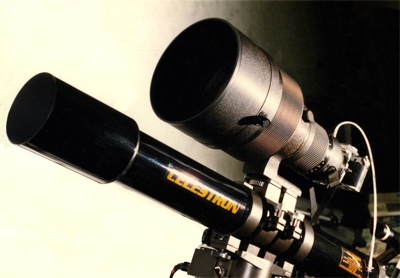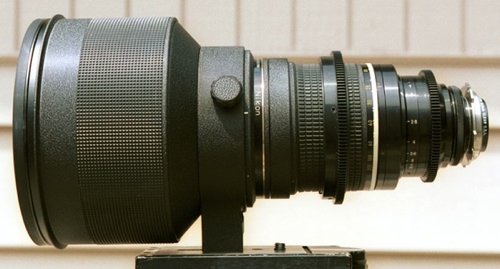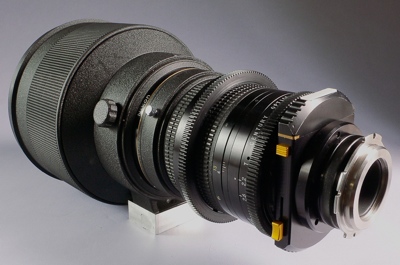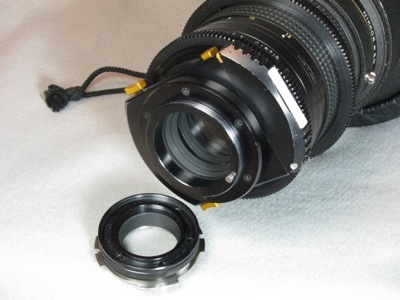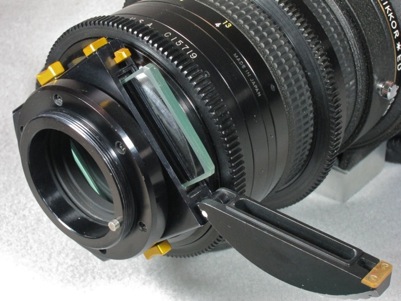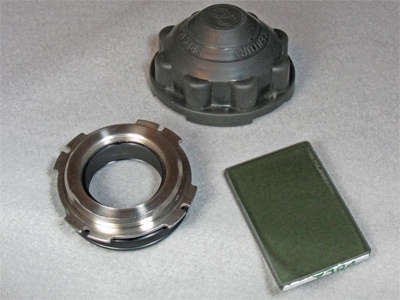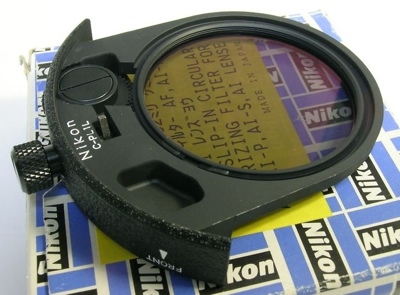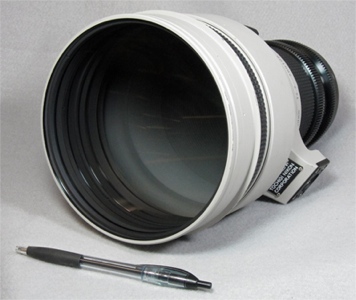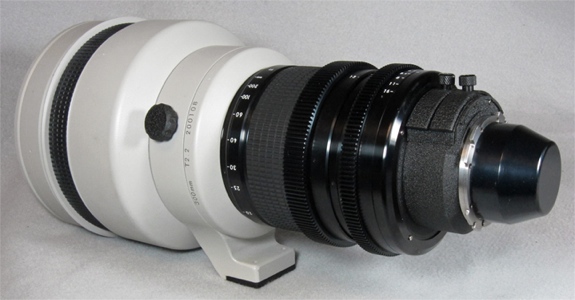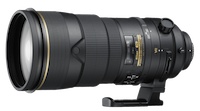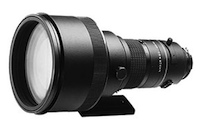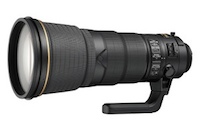Distribution
![]()
![]() Notes & Interesting Articles
Notes & Interesting Articles ![]() Nikon Overview
Nikon Overview ![]() Pricing
Pricing ![]()
![]()
![]() Special Optics
Special Optics


Nikon Nikkor 300mm f/2.0 ED IF and Tochigi Nikon 300mm T2.2
our tribute to these rare Nikon production ultra-telephoto lenses that remain unrivaled even today
To read this article roughly translated into Japanese, click here
Corporate Identity And Projects Leading Up To This:
There was a time decades ago when pride of innovation dictated corporate identity, more so than in recent years when decisions are often made by company bean-counters who may know the price of everything, but the value of nothing. This was when corporations including Nikon would put its best minds to work at developing truly amazing products, making more than only those products that simply made good commercial sense. Throughout the 1970’s and 1980’s their innovative work allowed Nikon to prosper and dominate the professional 35mm single lens reflex (SLR) camera and lens technology marketplace, while their corporate logo (shown above) became familiar to almost anyone world-wide. Their achievements include developing the world’s first high performance 200mm f/2 telephoto lens, since rivaled by other makers, and the world’s first and only high performance production 300mm f/2.0 telephoto lenses described here.
Right: Nikkor 300mm f/2 ED IF (SN 182429), the fastest 300mm lenses ever in routine production! Shown as displayed at Company Seven with a Nikon 35mm SLR camera attached and set up for wide sky astrophotography ‘piggybacked’ atop a 102mm refracting guide telescope and German Equatorial mount (41,849 bytes).
Soichi Nakamura, Kiyoshi Hayashi, And Their Lenses:
What we now know as the Nikon company was from its inception in 1917 through 1988 named Nippon Kogaku Kogyo Kabushikigaisha, this is japanese for Japan Optical Industries Corporation. Going into the 1970’s among Nippon Kogaku’s best telephoto lens designers was Mr. Soichi Nakamura. By the mid 1970’s Mr. Kiyoshi Hayashi was assigned to work with Mr. Nakamura in the then Optical Section 1, Optical System Department. For his first design project at Nikon Mr. Hayashi worked with Mr. Nakamura to develop the world’s first high performance 200mm f/2 telephoto lens, a design completed in 1976 and with the first production lenses selling in April 1977. Originally marketed as the Ai Nikkor 200 mm f/2S IF-ED, this was an amazing lens design with a then unprecedented 122mm aperture front lens. This was patented on 4 December 1979 as the "Telephoto Lens With Large Relative Aperture".
Providing faster shutter speeds than those possible with other contemporary lenses, this 200mm lens provided sports photographers with the capability to employ shutter speeds fast enough so that they might better capture the gentler moving actions of gymnasts and other athletes. The comparatively fast maximum f/2 focal ratio also allows the photographer to attain a very shallow depth of field, an effect that while keeping the object of interest clear and in focus gradually blurs out objects in the foreground and background. Telephoto lenses, particularly as they pass 200mm and higher focal lengths, provide a compressed perspective where objects near and distant in the image appear closer together than they actually are; this too provides the photographer with some artistic latitude when composing an image. This 200mm lens allowed the photographer to focus onto subjects closer to the lens than its predecessor lenses could. And finally, the large aperture makes objects appear brighter in the viewfinder, hence the photographer can focus quicker with better precision. The 200mm f/2 was an instant success with sports and news photographers, as well as with the more demanding and better financed amateur.
The 200mm f/2 was followed later in 1977 by the Nikkor 300mm f/2.8 EDIF, similar in concept with the 122mm front aperture but owing to its larger size provided with a tripod adapter and drop-in 39mm filters at the rear. Of course with a matched Nikon 2X Teleconverter these lenses could be employed as 400mm f/4 and 600mm f/5.6 lenses.
Mr. Hayashi pushed the envelope of lens design even farther when in 1981 he and his team completed the design of the new Ai Nikkor IF-ED 300mm f/2.0. It was developed in anticipation of its use covering indoor sports at the 1984 Olympics that commenced in February at Sarajevo. Mr. Hayashi’s team built the 300mm f/2 upon the experience gained as they developed other lenses including the Nikkor 200mm f/2 ED IF of 1977, but the 300mm f/2 is actually a much more complex design and with several more optical elements than those incorporated in the 200mm f/2. Production of the lens was assigned to Nikon’s Sagamihara Plant, a facility opened in 1971 that would host numerous lens innovations including Nikon’s first lenses that incorporated aspherical components. In the year 2000 the entire section was relocated to the Nikon Tochigi facility, but more about them later in this article.
The lens (with matched TC-14C Teleconverter) was introduced in 1983 at a then astounding list price of $6,500 U.S. Dollars; note this was at a time when the exchange rate was on the order of 238 Yen per Dollar. By 2016, adjusted by about 2.32x for inflation and updating the Dollar to Yen rates, the new lens set could cost about $32,927. By 2024 this had increased to $43,821!
The Instruction Manual accompanying the lens greeted the reader with Nikons’ statement to the world:
The group filed a US Patent application for this fast telephoto lens on 23 July 1984 but this original application was abandoned and filed on 20 January 1987 to also include design aspects of its cousin, the Nikon 400mm f/2.8 ED IF lens. That Patent was granted on 22 March 1988.
Kiyoshi Hayashi continues to work in the development of advanced optics. He and his associates have garnered numerous patents starting in the 1970’s and continuing into the twenty first century. Even as this article is written in 2011, his Nikkor 300mm f/2 ED IF lens and its 2004 cousin (described below) remain unrivaled. Company Seven considers this such an impressive accomplishment that we maintain one or more versions of the lens on display at our showroom/museum collection.
ED and IF:
Right: the business end of a Nikkor 300mm f/2 ED IF lens, displayed at Company Seven. It is like looking into the mouth of a Whale! Shown with lens shade retracted in stowed position, and without the provided HE-1 Hood Extension attached (81,921 bytes).
Historically focus was achieved by varying the distance between optical components of a lens and the camera by means of a ’total drawing-out’ focusing mechanism, this moves the objective (front elements) of a lens closer to or farther from the camera depending on the distance from the lens to the object - near or infinity (∞) focus. When using this arrangement with lenses of 200mm focal length or less, this can provide acceptable results. But for lenses greater than 200mm one must compromise, giving up near focus capability in order to manage the various aberrations. Components of these lenses too must be scaled up to deal with the larger and bulkier arrangement. The mechanics necessary to shift larger and larger lens elements become bulkier and heavy, often complicated by the need to keep components movements smooth and consistent along the full range of focus. The diaphragm of the longer lenses can become so large that it is difficult for the coupled automatic diaphragm linkage of a camera to control the diaphragm when releasing the shutter. However the Internal Focus (IF) design provides focus is changed by moving only a few optical elements built within the lens. So in an IF lens the overall physical length of the lens does not change when focusing since only internal components shifted. Internal focusing allows a lens to be made in a more durable and weather resistant arrangement. IF lens arrangements can be made to provide excellent performance and at nearer focus capability than their conventional cousins. An added bonus is that when focusing the longer IF lenses in particularly, then the weight distribution does not change forward or backwards therefore there is no need to adjust balance or the tension of the lens support (tripod, etc.). IF designs have since become adopted for use with more compact autofocus lenses as this provides the lens may be controlled with smaller motors, and with less current demands.
The multilayer coating process prevents light reflection off the surface of, or between the lenses. This process and internal baffling virtually eliminates ghost images and flare, and it improves color rendition. All of this achieves a dramatic increase in image contrast and actual light transmission, along with a corresponding reduction in flare that would otherwise be caused by internal reflections.
Nikon’s Nikkor 300mm f/2 ED IF is among the most rare of their production lenses with approximately four-hundred forty one (441) being manufactured, including a prototype, between the Summer of 1983 and into 1985. The system incorporates eleven elements arranged in three working groups, this is how it is described in the Patent however, most specifications characterize elements that are not cemented together as separate hence some people will describe this as eleven elements in eight groups:
Above: profile of the Nikkor 300mm f/2 ED IF lens with lens shade extended and with over-layed optical arrangement as designed (21,207 bytes).
The Nikkor 300mm f/2 ED IF lens bears the in-house Nikon Product Code JAA31401:
The TC-14C Ai-S Teleconverter bears Nikon Product Code JAA90501. With the number 9 representing teleconverter, 05 indicates this was the fifth lens in the sequence.
Right: the Nikon TC-14C Ai-S Teleconverter is clearly engraved with the mention that it is designed specifically for use with the 300mm f/2.0 EDIF lens (27,160 bytes).
With the provided Nikon TC-14C Ai-S Teleconverter, an attachable 1.4X focal length multiplying accessory, the 300mm f/2.0 lens could do double duty as a 420mm f/2.8 lens and with absolutely no loss of quality. Or with an optional Nikon TC-201 Teleconverter it operates as a 600mm f/4, while with the Nikon TC-301 Teleconverter it can operate as a 600mm f/5.6. So that one lens when paired with those two compact accessories allows the photographer great flexibility, and with no compromise of image quality, or reduction of maximum f/ratio below what the best alternative lenses (400mm f/2.8, 600mm f/4) offered. The lens and the recommended optional Teleconverters too incorporate an automatic indexing (AI) linkage that interfaces between the aperture control lever of the camera body and that of the lens. In the AI system the lens diaphragm is left open to the maximum aperture while observing and focussing, then as the shutter is tripped the lens is instantly stopped down to whatever aperture setting the photographer selected, then after the exposure the diaphragm returns to its normal open state. Of course the professional Nikon cameras allow ’stop down’ metering too, where the photographer overrides the default system and can manually stop down the diaphragm.
Click on image to see enlarged view (288,973 bytes).
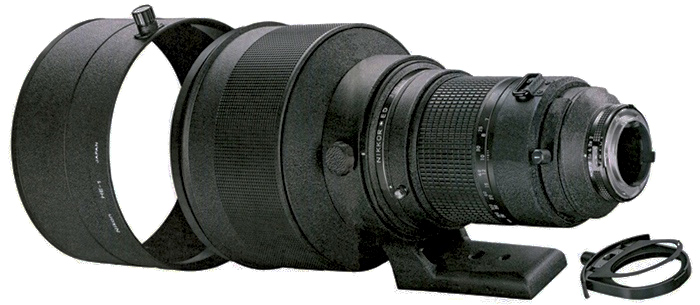
Above: Nikkor 300mm f/2 ED IF Lens shown with provided Lens Shade Extension HE-1, 52mm Drop-in Filter Holder installed, and Drop-in Gel Filter Holder (95,750 bytes).
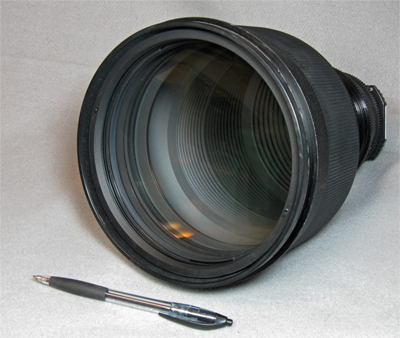 Most of the innovations in camera lens technology over this period could be attributed to improved performance of calculators and computers used to model the optical designs, computer assisted manufacturing equipment, and to the advanced glass types developed and with consistently higher purity (homogeneity, etc.) that would permit engineers to push the boundaries of lens tech. The ED suffix of a Nikon lens indicates the optics incorporate one of the then recently developed special dispersion crown glass elements often termed ’Extra-Low Dispersion’. The Nikon ED lenses are designed to provide precise optical color correction. Colors of the spectrum have differing wavelengths, and so in a normal optical glass prism the red and blue rays are slowed and bent at slightly different angles as they pass through the prism. This dispersion results in the appearance of chromatism, a color fringing and overall reduction of sharpness. In normal and wide-angle lenses this is imperceptible or corrected with other techniques but telescopic lenses magnify the variation in focus between red and blue light rays so that this becomes perceptible. It was to solve this problem of lens design that fluorocrown ED glass types and its successors have been developed to solve this problem.
Most of the innovations in camera lens technology over this period could be attributed to improved performance of calculators and computers used to model the optical designs, computer assisted manufacturing equipment, and to the advanced glass types developed and with consistently higher purity (homogeneity, etc.) that would permit engineers to push the boundaries of lens tech. The ED suffix of a Nikon lens indicates the optics incorporate one of the then recently developed special dispersion crown glass elements often termed ’Extra-Low Dispersion’. The Nikon ED lenses are designed to provide precise optical color correction. Colors of the spectrum have differing wavelengths, and so in a normal optical glass prism the red and blue rays are slowed and bent at slightly different angles as they pass through the prism. This dispersion results in the appearance of chromatism, a color fringing and overall reduction of sharpness. In normal and wide-angle lenses this is imperceptible or corrected with other techniques but telescopic lenses magnify the variation in focus between red and blue light rays so that this becomes perceptible. It was to solve this problem of lens design that fluorocrown ED glass types and its successors have been developed to solve this problem.
Click on image to see enlarged view (182,001 bytes).
Production Nikkor 300mm f/2 ED IF Overview:
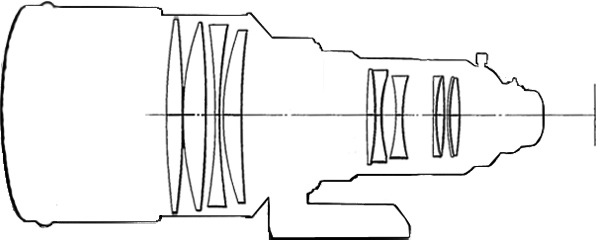
Not shown here are the front protective flat glass element or the drop-in 52mm filter at rear; these are included with production lenses.
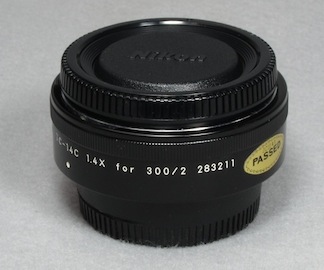 The Nikkor 300mm f/2 ED IF lens was sold by Nikon only as a set designated Part Number 1472 that included: the lens with retracting lens shade and one drop-in 52mm L37c thread-in filter with 52mm filter holder installed, slip-on leather front lens cover, soft fabric carrying strap attached to the lens, Nikon LF-1 Rear Lens Cap. Also included is a slip-on HE-1 Lens Hood Extension (P/N 605), the Nikon TC-14C Ai-S Teleconverter with front and rear covers, one 52mm drop-in gelatine filter holder, fitted keyed CT-300 Lens Case (P/N 4420), instruction manual, and warranty card.
The Nikkor 300mm f/2 ED IF lens was sold by Nikon only as a set designated Part Number 1472 that included: the lens with retracting lens shade and one drop-in 52mm L37c thread-in filter with 52mm filter holder installed, slip-on leather front lens cover, soft fabric carrying strap attached to the lens, Nikon LF-1 Rear Lens Cap. Also included is a slip-on HE-1 Lens Hood Extension (P/N 605), the Nikon TC-14C Ai-S Teleconverter with front and rear covers, one 52mm drop-in gelatine filter holder, fitted keyed CT-300 Lens Case (P/N 4420), instruction manual, and warranty card.
This is also compatible with the Tochigi Nikon 300mm T2.2 lenses (explained below) provided the lens has a Nikon F bayonet mount. Image of component in our collection.
To see enlarged view, click on the above image (90,745 bytes).
- Focal length (with full frame FX format Nikon bodies): 300mm
- Maximum aperture: f/2.0
- Front Aperture: 152.54mm (6.01 inch)
- Field of View: 8°10’
- Apparent Focal length (with DX format Nikon bodies): 465mm
- Lens construction: 11 elements in 8 groups, plus a dust proof glass plate built into front cell and one drop-in 52mm filter (glass or Gel) at rear
- Diaphragm (Iris): fully automatic, can be set to f2, 2.8, 4, 5.6, 8, 11, or 16
- Distance scale: graduated in Meters and Feet, from 4m (13.1 ft) to infinity (∞) and with Depth of Field indicators. Infrared focusing index provided
- Aperture scale: f/2.0 - f/16 on both standard and aperture-direct-readout scales
- Exposure measurement: full-aperture method; meter coupling ridge provided for Al cameras with a meter coupling shoe for non-AI cameras
- Focusing: Manual Nikon Internal Focusing (IF) system; focusing collar stop can be preset to stop at any distance setting
- Focus Distance Minimum: 13 feet (4 meters), any distance can be preset by click-stop ring
- Lens Mount: Nikon F bayonet AIs this lens can be attached onto any Nikon SLR camera made since 1959
- Lens Rotating Collar: built-in tripod mounting collar rotatable through 360°, with adjustable drag and lock
- Dimensions: 13 x 7.15 inches (330mm x 183mm)
- Weight: 16.6 lbs. (7.5 kg)
- Lens Hood: built-in telescoping hood section screws into either stowed or extended positions
- Slip-on Nikon HE-1 (“Hood Extension 1”) Lens Hood
- Filters: glass 52mm filter threads into drop-in filter holder, or gelatine slips into provided holder
- Nikon LN-1 adjustable length Carry Strap, fabric attaches to lens strap loops.
- Lens Cover, black leather with Velcro fastener and adjustable drawstring, brown fabric padded lining.
- Nikon LF-1, F Mount Cover, black plastic.
- Maximum aperture: T/2.2
- Field of View: depends on choice of film camera
- Diaphragm (Iris): fully manual, can be set to T/2.2, 2.8, 4, 5.6, 8, 11, 16
- Distance scale: graduated in meters and feet from 4m (13.1 ft) to infinity (∞) with Depth of Field indicators. Infrared focusing index provided
- Exposure measurement: manual ’stop down’
- Lens Mount: Century Neutral Mount, accepts optional interchangeable camera adapters
- Rotating Collar: built-in tripod mounting collar rotatable through 360°, with adjustable drag and lock
- Tripod Attachment: via one 3/8 inch - 16 tpi tapped hole
- Dimensions (front edge to lens mount): 13-5/8 x 7.15 inches (346mm x 183mm)
- Lens Weight: 17 lbs. 14.7 ounces (8.14 kg) with glass filter in filter holder
- Lens Hood: built-in telescoping screws into stored or extended positions, extension Nikon HE-1 Lens Hood provided
- Filters: slide-in glass 2-11/16 x 1-3/4 x 3/16 inch thick
- lens aperture readout scale is engraved in T-Stop increments.
- A decade after their introduction Nikon Japan informed me these lenses were all originally made with the Arri PL camera bayonet mount. While some Nikon literature of 2004 mentions a Nikon F mount too, according to the factory none were actually produced with the F mount. Unlike the original Nikkor 300mm f/2 ED IF lenses, the lens mount of the Tochigi Nikon 300mm T2.2 can be removed and another mount can be custom-fitted; this should be attempted only by an experienced lens technician with machine-shop support. Thus the user may arrange to exchange the camera attachment hardware from Nikon to Arriflex, or from Arri PL to Canon EOS or Nikon for example. More about this later in this article.
- Lens incorporates precision machined spur gear wheels over the focus and diaphragm controls for focus by hand or by other devices.
- As with most purpose-built cinematography lenses, the focus control of this lens dials clockwise to change focus from infinity (∞) to near. This is the opposite rotating direction of the focus control on most consumer lenses, and is a feature that even Century could not add to their retrofit versions (above) of these lenses. The distance scale reads only in feet thus eliminating any possibility of a cinematographer or assistant confusing Feet with Meters, as are indicated on conventional lenses.
- Two drop in filter slots are provided at the rear, either can accept a 52mm glass or Gel filter or a Nikon C-PL series Polarizing Filter and holder.
- Both lens shade sections are completely removable: the lens hood, formerly retracting on the Nikkor 300 f/2 ED IF, is a slip-on arrangement with an extension section5.
- The foot of the tripod mounting collar is shorter and more compact to accept a variety of hardware for securely attaching the lens onto various stands or quick-release brackets.
- Maximum aperture: T/2.2
- Front Aperture: 150.0mm (5.91 inch)
- Field of View: depends on choice of film camera
- Diaphragm (Iris): fully manual, can be set to T/2.2, 2.8, 4, 5.6, 8, 11, 16
- Distance scale: graduated in meters and feet from below 4m (13.1 ft) to beyond infinity (∞).
- Exposure measurement: manual ’stop down’
- Lens Mount: accepts a bolt-on lens mount, currently Arri PL
- Lens Back Focus: 52.00mm (2.05 inch) from rear surface of lens PL mount flange ring
- Rotating Collar: built-in tripod mounting collar rotatable through 360°, with adjustable drag and lock
- Tripod Attachment: via one 3/8 inch - 16 tpi bolt, or four 4mm thread count 0.7
- Length (front edge of lens to lens mount flange): 329.2mm (12.96 inch)
- Length (front edge of stored Lens Hoods sections to rear of lens mount cover): 455mm (17.9 inch)
- Length (front edge of Lens Hood to rear of lens mount cover): 527mm (20.75 inch)
- Diameter overall: 163mm (6-7/16 inches)
- Weight (without Lens Hood): 16 lbs. 0.9 ounces (7.28 kg) with leather Lens Cover
- Lens Hood: HK-29-1 section clamps onto front of lens, Nikon HK-29-2 Lens Hood extension section provided
- Lens Hood Weight: 15.9 Oz. (0.45 kg) includes both Lens Hood and Extension section
- Filters: two (2) slide-in thread-on filter holders for glass 52mm filters, provided with two Nikon NC filters.

Above: side and front views of Nikon 300mm f/2.0 EDIF lens rear module incorporating: bayonet mount, AiS indexing and aperture stop down hardware, aperture
readout scale, variable diaphragm (stopped down to f/2.8), 52mm drop-in filter holder, lens carrying strap hooks (92,442 bytes). Image of component in our collection.
To see enlarged view, click on the above image (128,291 bytes).
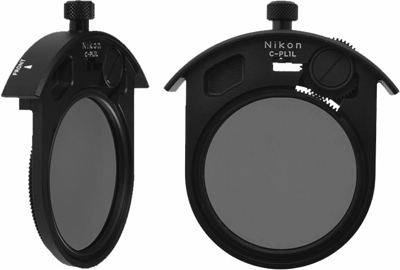 Filtering is provided for by means of the 52mm ’drop-in’ filter slot near the rear of the lens that accepts either of the two provided filter holders, one for a thread-in 52mm diameter filter and the other for slip-in gelatin filter. The 300mm f/2 ED IF has this in common with its cousins the Nikon 400mm f/2.8 ED IF and the 600mm f/4 ED IF series lenses. The conventional 35mm film format dimensions are 24mm tall x 36mm wide with a diagonal of 43mm, so the 52mm filter can cover the entire film frame with no vignetting. The provided filter holders are resistant to dust and dirt, but their slip-in ports are not waterproof. The provided L37c filter absorbs ultraviolet wavelengths below about 370 nanometers thereby preventing ’blue blur’, hence the designation L37. The ’c’ suffix indicates the front and rear of the filter has NIC antireflection coatings (the same multi-coatings as on Nikon lenses) to prevent causing reflections or ghost images.
Filtering is provided for by means of the 52mm ’drop-in’ filter slot near the rear of the lens that accepts either of the two provided filter holders, one for a thread-in 52mm diameter filter and the other for slip-in gelatin filter. The 300mm f/2 ED IF has this in common with its cousins the Nikon 400mm f/2.8 ED IF and the 600mm f/4 ED IF series lenses. The conventional 35mm film format dimensions are 24mm tall x 36mm wide with a diagonal of 43mm, so the 52mm filter can cover the entire film frame with no vignetting. The provided filter holders are resistant to dust and dirt, but their slip-in ports are not waterproof. The provided L37c filter absorbs ultraviolet wavelengths below about 370 nanometers thereby preventing ’blue blur’, hence the designation L37. The ’c’ suffix indicates the front and rear of the filter has NIC antireflection coatings (the same multi-coatings as on Nikon lenses) to prevent causing reflections or ghost images.
Left: Optional Nikon C-PL1L Circular Polarizing Filter, as see from the quarter and rear perspectives.
On the rear view note the geared focus control wheel to the right side on the top cover (25,033 bytes).
The drop-in filter holder could accommodate a polarizing filter however, the only way to adjust the orientation of the filter to the target is to loosen the Nikkor’s Mounting Collar and rotate the lens. Unfortunately this causes not only the lens but also the Nikon camera at the rear to rotate and may put the camera in some unfavorable orientation to compose the photo. Years after the 300mm f/2 ED IF were discontinued Nikon introduced the ’C-PLxL’ series of drop-in filter holders, a valuable optional accessory for anyone taking pictures out doors. Each one includes a thread-on Nikon Circular Polarizing Filter. The holder incorporates a geared mechanism so that even when the filter is installed into the lens the photographer can rotate the filter to any desired orientation, as much as 360 degrees.
A circular polarizing filter is the preferred choice whenever using most modern cameras that employ a through-the-lens (TTL) center-weighted metering system. But note the use of multi-sensor metering camera may result in incorrect exposure. There are several variants of these filter holder sets produced by Nikon however, the only model that properly fits the 300mm f/2 ED IF lens is the Nikon C-PL1L (Part No. 2474). One last caution the C-PL1L filter holder is not resistant to dust or dirt, and are not waterproof.
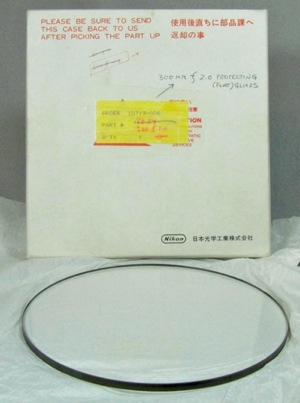 While the lens accepts drop in filters near the rear, unlike many other camera lenses the forward end of the 300mm f/2 ED IF is not provided with filter threads or any other means to attach a filter at front. Instead of a thread-on filter the lens incorporates a multicoated window, an optical flat element, for the protection of the front element of the lens. This window is held in place by a thread-on retaining so that if this window is damaged then it could easily be replaced by a service facility. Even though this ring appears to have threads that might permit attaching a filter, these threads are beveled and ribbed too therefore this can not accept any accessory.
While the lens accepts drop in filters near the rear, unlike many other camera lenses the forward end of the 300mm f/2 ED IF is not provided with filter threads or any other means to attach a filter at front. Instead of a thread-on filter the lens incorporates a multicoated window, an optical flat element, for the protection of the front element of the lens. This window is held in place by a thread-on retaining so that if this window is damaged then it could easily be replaced by a service facility. Even though this ring appears to have threads that might permit attaching a filter, these threads are beveled and ribbed too therefore this can not accept any accessory.
Right: a Nikon issue 4.94 mm thick protective flat window of a Nikkor 300mm f/2 ED IF lens. Stocked at Company Seven (29,768 bytes).
Click on image to see enlarged view (182,001 bytes).
We recall that in the mid 1980’s Nikon also sold an optional and then costly thread-in Nikon 160mm L37c filter. This filter was provided with its own protective hard leather case. Yet Nikon made no provisions for the user to use this or any other filter at the front of the 300mm f/2 ED IF lens. This means that if/when the protective window of these lenses is damaged, then the lens must be sent to Nikon (Melville, New York or Los Angeles, California) or to some specialist (Century/Schneider Optics) for servicing. Fortunately we do keep one replacement window at Company Seven (shown at right) - just in case.
The antireflection coated optical elements appear almost invisible to oncoming light, any reflection seen tends to come off the flat front window. The lens barrel interior is lined with precisely machined anti-reflection ribs, with the interior finished throughout with antireflection black. The adjustable iris diaphragm in the rear of the lens is treated to prevent internal reflections off the blades. The lens elements edges are darkened too. Looking into the lens leaves one with the impression of looking into a dark cave.
The basic specifications of the Nikkor 300mm f/2 ED IF lens are:
Nikkor 300mm f/2 ED IF Applications:
When the lens was initially released for sale in 1983 it was sought after by sports photographers, most notably those destined to cover events at the 1984 Olympics. In time many news and magazine publishing organizations added one or more of these lenses to their inventory. Most of the lenses kept in shared pool inventories show the wear and tear taken at the hands of users who were more concerned about getting the photo to maintain their status than keeping the lens in new condition. While those lenses paid for and owned by individuals tended to fare better. Most of the lenses were used atop either a monopod or a field tripod, though at f/2 the lenses could be hand-held at well lit events or when using faster films. Regardless of how these lenses were treated, their robust and first-rate construction assured none failed to deliver a good result.
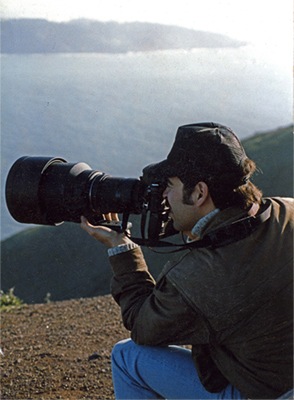 From the Summer of 1983 the lens was available for sale world-wide. It was in stock at some of those camera stores that were geared to serve the professional photographer, mostly in New York City, until well into at least 1986. However, most camera stores would not stock or show this lens instead ordering them for customers only as needed. As the limited market for these lenses became saturated the last of these new lens sets sold from New York mail order houses in around 1986. As an example of the final selling prices of these lenses, the owner of Company Seven bought his 300mm f/2 ED IF in 1986 for $4,200 (USD); for comparison consider in 1978 he purchased a new large Ford 4-door sedan for $4,800.
From the Summer of 1983 the lens was available for sale world-wide. It was in stock at some of those camera stores that were geared to serve the professional photographer, mostly in New York City, until well into at least 1986. However, most camera stores would not stock or show this lens instead ordering them for customers only as needed. As the limited market for these lenses became saturated the last of these new lens sets sold from New York mail order houses in around 1986. As an example of the final selling prices of these lenses, the owner of Company Seven bought his 300mm f/2 ED IF in 1986 for $4,200 (USD); for comparison consider in 1978 he purchased a new large Ford 4-door sedan for $4,800.
having such tack-sharp and fast lenses...provided him with an edge”
One of these lenses, SN 182429, was purchased by the co-founder of Company Seven who also did side work in news (appearing in The Washington Post, Associated Press), private, and concert photography. In addition to his innate aptitudes for composition and skills with the gear, having such tack-sharp and fast lenses (including Nocturnal Nikkor 58mm f1.2, Nikkor 200mm f/2 ED IF, Nikkor 300mm f/2 ED IF, etc.) provided him with an edge. His experience with hypersensitizing films added even more to his arsenal. He briefly experimented with his Nikkor 300mm f/2 ED IF for use in astronomy; as an astrograph it was basically a wide field 150mm (6 inch) aperture f/2.0 Apo refracting telescope. With this lens he took several time exposure astrophotographs of some larger deep-sky objects and with good initial results, the images show stars as pin-points across the black velour background of space at the imaging plane. But after that one session in the later 1980’s he never made it back out to a dark sky site with the lens and with a suitable tracking mount and the more sophisticated films to ring out the lens with more serious work.
Right: this is how a Real Man takes a picture. The founder of Company Seven photographing San Francisco from the heights overlooking Kirby Cove. Shooting with his Nikkor 300mm f/2 ED IF Lens (SN 182429), and Nikon F3HP SLR camera with MD-4 Motor Drive. With the Sun shining to his right rear quarter, the built-in lens hood is extended while the HE-1 remains attached but revered in its stored position. Note his technique when shooting hand-held to support, adjust focus and aperture of the lens - all with his left hand.
Scanned image of photo taken by a friend in February 1987, and sent with the note “Marty, and the unbelievable lens” (34,459 bytes).
Nikon provided the 300mm f/2 ED IF lens with a black fabric carrying strap, this was attached to rectangular steel loops that are bolted onto either side of the rear cell just behind the engraved focus distance scales. This allowed the photographer to carry this 17 lbs. of lens, with or without a camera attached, along his side. The owner of Company Seven recalls visiting San Francisco in February 1987 with his Nikon F3HP cameras and his 300mm f/2 ED IF lens. He obtained remarkable photos, most were hand-held, with his 300mm f/2 ED IF shooting with Kodachrome 64 film. The images include overviews of the city and Golden Gate Bridge as seen from the heights overlooking Kirby Cove northwest of the bridge, and from Alcatraz. He explained "at the end of that long day as I took off my shirt I noticed the carrying strap of my 300mm f/2 ED IF lens had left a deep reddened impression across my right shoulder. At first glance I thought I’d been scarred for life by it!"
The Nikon 300mm f/2 ED IF, while a remarkable accomplishment, was never destined for wide-spread use owing to its comparatively high cost and heavy weight. Since alternative lighter weight and less costly lenses were available, particularly the 122mm aperture Nikon 300mm f/2.8 ED IF weighing about 5.5 lbs. (2.5 kg), and as faster films came to market (including Konica 3200, Kodak 2485 High Speed Recording) fewer people could justify paying for the 300mm f/2 or carrying it around. The digital SLR cameras developed over the recent years are so improved in terms of resolution as well as in low light sensitivity so that aside from minor depth of field considerations, the results when using a 300mm f/2.8 or an even slower lens can rival or exceed the best that could have been accomplished using hand-held film cameras with the 300mm f/2.0. This is all before one considers autofocus and vibration reduction aspects ("for whimps" per the owner of Company Seven) of the newer technology lenses.
It is telling something about these massive lenses that when a used ’working’ (owned by a sports magazine, or newspaper) 300mm f/2.0 ED IF lens does come up for sale then it shows many signs of wear and tear, even modifications, and is often incomplete missing the TC-14c Teleconverter, lens hood, or carrying case. But when a used privately owned 300mm f/2.0 ED IF comes up, then it more likely to be complete and with very few signs of use or wear; it is easy to understand why mere mortals rarely used them.
 Cinematographers discovered the 300mm f/2 ED IF filled a niche in their inventory of lenses. The lens would have metal gear sets attached over the focus and aperture rials for use with ’follow focus’ rails and gearing; this to permit precise setting of focus and of aperture for each scene. As directors including Stanley Kubrick popularized the ’low light soft focus’ look by using ultra-fast lenses in films including Barry Lyndon others too rushed to mimic the effect. For those cinematographers seeking to work at close distances or in low light, or to obtain very shallow depth of field when working at around the 7x provided by the 300mm focal lengths, there was simply nothing equal to the Nikkor 300mm f/2 ED IF. And since their cameras with lenses are installed onto rail support systems and other rigid fixtures, then the bulk and weight of any lens would not be a limiting concern to the cinematographer.
Cinematographers discovered the 300mm f/2 ED IF filled a niche in their inventory of lenses. The lens would have metal gear sets attached over the focus and aperture rials for use with ’follow focus’ rails and gearing; this to permit precise setting of focus and of aperture for each scene. As directors including Stanley Kubrick popularized the ’low light soft focus’ look by using ultra-fast lenses in films including Barry Lyndon others too rushed to mimic the effect. For those cinematographers seeking to work at close distances or in low light, or to obtain very shallow depth of field when working at around the 7x provided by the 300mm focal lengths, there was simply nothing equal to the Nikkor 300mm f/2 ED IF. And since their cameras with lenses are installed onto rail support systems and other rigid fixtures, then the bulk and weight of any lens would not be a limiting concern to the cinematographer.
Right: cinematographer Don FauntLeRoy with Nikkor 300mm f/2 ED IF lens on location near San Diego in 1992, his first outing with his new lens. The lens is shown as he first employed the lens, with no special modifications. The lens, with it’s integral Lens Shade retracted here, is attached to the Panavion film camera (145,861 bytes).
Image provided courtesy of Don E. FauntLeRoy, ASC. This is cropped from his original to better show the camera and lens.
Click on image to see enlarged view (247,012 bytes).
It was not uncommon for cinematographers to purchase a conventional camera lens, acquiring their own arsenal of equipment based on their own preferences and filming job requirements. But by the early 1990’s cinematographers and studios were more and more relying on renting their more esoteric equipment only as needed for production work.
In order to make working with conventional lenses more practical for the needs of the cinematography community some of the lenses were modified. The modifications for cinematography could render the lens less practical for day to day conventional photography when the diaphragm (aperture) stop-down linkage could be among those components to be removed in order to accommodate alternative mounts for cinema cameras. Among the most prominent companies involved in providing modification services and or rental filming gear for cinematographers and to the studios are Arriflex, Panavision, and Century Precision Optics; these serve not only the Hollywood-based companies but also work with international film studios and their affiliates. These equipment companies often have to either make from scratch new cameras, lenses, and other equipment or they modify production equipment made for other markets to suit the needs of the film industry. The lens modifications allow third party (Canon, Nikon, Zeiss for example) lenses to attach onto their film cameras, and to be operated in ways familiar to the technicians of the cinematography field.
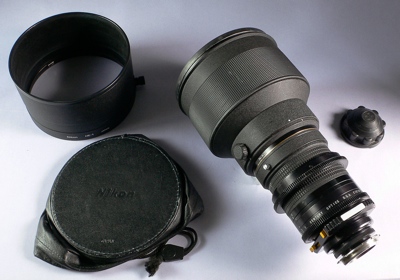
Left: Nikkor 300mm f/2 ED IF Lens (SN 182429) the fastest 300mm lens as modified by Century Precision Optics for cinematography. Shown to the side are the originally provided Nikon HE-1 Lens Hood and slip-on leather lens cover. To the side is the cover for the mount provided by Century Optics. Visible lens modifications are: bolted on metal gear sets for focus and diaphragm drives, aperture scale in T Stops, and changeable camera attachment mounting hardware (51,883 bytes).
This lens was purchased new from Nikon by acclaimed cinematographer Ward Russell. He arranged for Century Optics to modify the lens then he employed it when filming movies (including "Days of Thunder", "The Last Boy Scout", "X-Files, The Movie"), commercials, and other projects. The lens is in Company Seven’s collection.
Click on image to see enlarged view (194,292 bytes).
 Century performed serial modification of production Nikkor 300mm f/2 ED IF lenses sourcing new lenses directly from Nikon and its retailers, and after 1986 buying these lenses as they could be found on the used market. Century was then very quick to snap up almost any 300mm f/2 they could get hold of; we observed them buying used lenses within a day of their being advertised and for as much as $15,000. We wondered if these companies were not trying to dominate the world market by controlling the availability of these limited production lenses.
Century performed serial modification of production Nikkor 300mm f/2 ED IF lenses sourcing new lenses directly from Nikon and its retailers, and after 1986 buying these lenses as they could be found on the used market. Century was then very quick to snap up almost any 300mm f/2 they could get hold of; we observed them buying used lenses within a day of their being advertised and for as much as $15,000. We wondered if these companies were not trying to dominate the world market by controlling the availability of these limited production lenses.
Century also offered their modification service on a fee basis to customers who wanted their own lens adapted either to be better suited for cinematography, and or for use with camera bodies other than Nikon. Customers included companies around the world that rent lenses and other gear to the film industry.
 Panavision bought several Nikkor 300mm f/2 ED IF lenses for modifications that produced a result almost unrecognizable as having been built upon a Nikkor lens. The Panavision changes address most of the items mentioned below including an interchangeable camera adapter, focus and diaphragm geared controls even if some are implemented with a different techniques. Most purpose-built cinematography lenses control focus by turning the focus grip clockwise to change focus from infinity (∞) to near; this is the opposite rotating direction of the focus control on most consumer lenses. Panavision conversions alter the focus control helicoil to match the focus turning direction of other Panavision and industry lenses. The Panavision version of these lenses resemble the Nikkor 300mm f/2 EDIF from the front to as far back as the original ring that has the ’Nikon’ with lens model and serial number engraved, but from there back the original lens focus and aperture mechanics have been removed and replaced by a more smooth barreled machined body. The focus distance scales is prominent, with large yellow numbers. The Panavision version of the lens designated the SPN300, described as a 300mm T2.2 and fully Panavised.
Panavision bought several Nikkor 300mm f/2 ED IF lenses for modifications that produced a result almost unrecognizable as having been built upon a Nikkor lens. The Panavision changes address most of the items mentioned below including an interchangeable camera adapter, focus and diaphragm geared controls even if some are implemented with a different techniques. Most purpose-built cinematography lenses control focus by turning the focus grip clockwise to change focus from infinity (∞) to near; this is the opposite rotating direction of the focus control on most consumer lenses. Panavision conversions alter the focus control helicoil to match the focus turning direction of other Panavision and industry lenses. The Panavision version of these lenses resemble the Nikkor 300mm f/2 EDIF from the front to as far back as the original ring that has the ’Nikon’ with lens model and serial number engraved, but from there back the original lens focus and aperture mechanics have been removed and replaced by a more smooth barreled machined body. The focus distance scales is prominent, with large yellow numbers. The Panavision version of the lens designated the SPN300, described as a 300mm T2.2 and fully Panavised.
-
1. f/Stop or T-Stop? In photographic applications the F-Stop number (or focal ratio) is the result of a mathematical relationship: Focal Length ÷ Aperture Diameter = F / Stop. The F-Stop number is an indicator of how bright the image will be, and what the depth of the field in focus will be. This scale is practical for most markets where cameras incorporate a light meter that will measure these levels and adjust shutter speed accordingly. But the cameras employed in cinematography historically have not incorporated a light meter, so these measurements are made by hand-held meters and fine-tuned by the experienced cinematographer.
As light passes through a lens some is lost to reflection off each lens surface, while some is absorbed in the glass elements. This loss may be as little as one percent per surface, and only 0.001 percent per 5mm of lens thickness of some glass types. In simpler lenses with few elements the loss does not amount to much for example, a well made normal lens of 50mm f/1.8 may loose five percent but this is likely insignificant in practice. But in the best made of the more complicated telephoto and zoom lenses there are numerous and larger elements, up to thirteen elements with twenty surfaces in the 300mm f/2 ED IF, so the loss will be appreciable to the cinematographer. It is vital to know the actual net light throughput of a lens otherwise a film maker might not know the results of a days filming until after the costly film had undergone costly processing. The film maker would not want to pay a team to reshoot scene after scene while bracketing the diaphragm at various settings with the hope of getting a perfect exposure. So cinematographers rely on the ’T-Stop’, a scale devised through calculations that factor in light loss, to more accurately represent the relative brightness settings of a lens and with that calculate a proper exposure.
So while these lenses are each a modified Nikkor 300mm f/2.0, the cinematography industry characterizes them as a 300mm T2.2. Otherwise, optically it is the same lens but with a different scale assigned to the diaphragm. Also note a T2.2 lens for example requires only half the foot candles of illumination to film a scene as does a T2.8 lens, or one quarter the illumination of a T4 lens.
2. The result leaves a male-thread ’Century Interchangeable Mount’ at the rear of the lens. The mounts we have with the display lens are for Arriflex PL and another for Panavision PV. In addition to using the lens with any cinematography camera any camera mount that is made in the popular T-thread could be adapted for use on this lens. It would be a simple matter to buy a Century T-Mount Adapter (PN 0TM-00CT) then add a Nikon T-Mount Flange (0TM-T2N1) to adapt this to Nikon F Mount cameras for example - all with no tools needed! It is important to comply with the lens back focus standards provided by the adapters made by Century otherwise if using inappropriate third party hardware the lens may not reach focus at near or at infinity settings, there is more discussion about the matters of back focus in the section below about the Tochigi Nikon production lenses.
The removal of the original Nikon F bayonet mount eliminates the Automatic Indexing (AI) and Auto Iris (diaphragm) control linkage. So when focussing the lens one can manually rotate the diaphragm control as desired to see the brightest view, then manually reset the control to the desired T-Stop setting(s) for the filming session. The loss of AI is practically speaking not a concern since the metering and shutter exposure will be set based on the diaphragm setting at the moment the camera shutter is tripped; this technique is referred to as "stop-down metering".
3. So that a geared ’Follow Focus’ device can be attached to permit precise and repeatable settings of the focus and aperture. These may be manually operated or motorized for local control or remote control by radio or wire. Lenses equipped to accept such devices are beneficial for astrophotographers too whose CCD cameras and focus control software can automatically control focus over long sessions even where ambient temperature changes might impact precise focus.
Century engraves their own identifying serial number on their rear lens assembly, their component on our 300mm f/2 lens for example reads "C15719".
Filter provisions for some but not all of these Century-modified Nikkor lenses is by means of a slide-in filter holder devised by Century and marketed as the "Tele Fx" (pronounced telefex). That would be built-in near the rear of the lens, and unlike the original Nikkor 300mm lens, the filter housing is located behind the iris diaphragm. This holder accepts durable slip-in rectangular 45mm x 70mm filter, each cut from the 3 x 3 inch square filter elements as are commonly used in the film industry. The Century Tele Fx were marketed in either a Single Stage and Dual Stage configuration, where the single stage has one filter holder and a dual stage version accepts up to two filters in line. The choice of dual or single would be a matter of preference for the cinematographer as long as the lens had the back-focus to accommodate that preference. The lens in our collection has the Single Stage Tele Fx:
The filters in the photographic and film industries are commonly identified by a Kodak Wratten number. Each lens would be provided with some assortment of filters anticipating various set lighting conditions. For example the filters provided with the Century-modified lens in our collection includes: clear, color compensating 85, 85n3, 85n6, and 85n9 filters. When these were in routine production, and before Century Precision Optics was acquired by Schneider Optics, the filters were made by Tiffen Mfg. of New York and each filter bears that trade name.
Having a filter in the holder changes the back focus distance (focal plane position behind the lens) by about 1/3 the thickness of the filter glass. So even when filming a scene called for no filter to obtain a special effect, a clear filter is installed into the holder so that when the scene was being prepared for filming, by doing this there will be no changes of focus whether or not a filter was changed later. If you look closely at the 1980’s ’clear’ filter in the Tele Fx filter holder above you will see the glass has a greenish tint, this is indicative of a fairly inexpensive glass that introduces some false color cast. This chromatism is not a practical concern in typical filming, though it would cause stars in an astrophotograph or pinpoint light sources in a film scene, if examined closely to appear with a purplish fringe halo. The more recently provided clear filters are since made by either Tiffen or Schneider with ’water white’ glass, a superior low-iron glass that appears completely transparent and multicoated, and with a diminished green tint of color to the eye when viewed from the edge.
As with the original Nikkor version of the 300mm f/2 ED IF lens the drop-in filter holder could accommodate a polarizing filter however, the only way to adjust the orientation of the filter to the target is to loosen the Nikkor’s Mounting Collar and rotate the lens. Even after the Century modifications the rotation feature is useable. This causes no inconvenience since the camera adapter flange at the rear of the lens can be loosened and rotated then secured again to put the camera in the most favorable orientation to compose the filming. Fortunately the cinematographer has time to adjust all aspects of a lens and lighting prior to the director’s call "Action!" So the rotating of the entire lens is practical for this work.
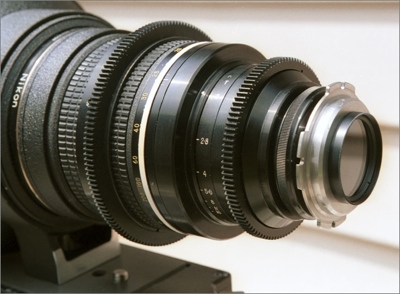 There are Century-modified lenses such as the one at right for example where the owner elected not to have any filter holder built into the lens, instead relying on threading a filter onto the Camera Lens Adapter Ring at the end of the lens. For example, the cinematography lens can be fitted with a PL bayonet mount adapter and then have one 40.5mm diameter filter or even two filters, one threaded into the other, attached to the mount adapter. This arrangement works in the film industry where the Normal frame size (sometimes termed the Academy Standard is about 22 mm by 18.6 mm or about half that of conventional 35mm format photography, sometimes termed Half Frame 35. The use of filters as small as the 40.5mm diameter would not be suitable for use with the conventional 35mm film format of 24mm tall x 36mm wide and the diagonal dimension is 43mm, so use of a 40.5mm filter would cause vignetting at the corners. There are several larger film formats sometimes used in the cinema industry based at least one that still photographers refer to as their "Normal" 35mm frame, those on the cinema side call the VistaVision format created by engineers at Paramount Pictures in 1954.
There are Century-modified lenses such as the one at right for example where the owner elected not to have any filter holder built into the lens, instead relying on threading a filter onto the Camera Lens Adapter Ring at the end of the lens. For example, the cinematography lens can be fitted with a PL bayonet mount adapter and then have one 40.5mm diameter filter or even two filters, one threaded into the other, attached to the mount adapter. This arrangement works in the film industry where the Normal frame size (sometimes termed the Academy Standard is about 22 mm by 18.6 mm or about half that of conventional 35mm format photography, sometimes termed Half Frame 35. The use of filters as small as the 40.5mm diameter would not be suitable for use with the conventional 35mm film format of 24mm tall x 36mm wide and the diagonal dimension is 43mm, so use of a 40.5mm filter would cause vignetting at the corners. There are several larger film formats sometimes used in the cinema industry based at least one that still photographers refer to as their "Normal" 35mm frame, those on the cinema side call the VistaVision format created by engineers at Paramount Pictures in 1954.
Left: a Century-modified Nikkor 300 f/2 lens. This lens was not ordered with the Tele Fx but instead relies on using a 40.5mm filter threaded onto the camera adapter ring. In this image the clear filter is shown threaded onto the Arriflex PL camera adapter. Image courtesy of Bill Bennett, ASC; used by permission (57,667 bytes).
Click on image to see enlarged view (177,463 bytes).
The rear of the original Nikkor lens was replaced by Century with a new fully machined assembly that incorporates an adjustable iris diaphragm. The blades of the Century-modified lens diaphragm are anodized black but we are concerned this finish alone will not be as good at preventing internal reflections off the blades as the original diaphragm was on the Nikkor lens. We could see these blades open and close quite readily when looking into the lens. Practically speaking this is not likely to be a concern when the lens is used at its full open (T2.2) setting or in most typical cinematographic lighting circumstances.
While the lenses were modified we understand that at least Century also offers optional teleconverters that they describe as an ’extender’. For example one may buy a 1.4x or 2x extender bearing the ’Century Optics’ trade name. These may bear a letter designating which lens series they are compatible with. We do not know if Century and Panavision modified the Nikon TC-14C to be offered with their lenses. Nor, do we know if they are offering their version of the 2X TC-301 recommended by Nikon for use with the 300mm f/2 ED IF lenses.
As this article was researched in early 2011 the Century-modified 300mm f/2 ED IF lenses rent to film production companies and cinematographers for about $300 per day. Panavision too rents their version of the lens designated the SPN300. These lenses remain among the fastest of all telephoto lenses employed in cinematography; it is rare to see any lens with a focal length greater than 200mm with a faster T-Stop rating. Given how filming projects tend to be shooting over weeks or months it is easy to see how $15,000 can be a sound investment when the maximum cost of a lens may recouped in only fifty or so days of rentals.
The specifications that differ of the Nikkor 300mm f/2 ED IF lens (SN 182429) as modified by Century and shown here are:

Above: parts left over after the conversion of Nikon 300mm f/2.0 EDIF to T2.2 lens by Panavision (92,442 bytes). This changed not only the rear of the
lens housing the diaphragm and indicator, as did Century, but Panavision also changed out the focus mechanism too. Image of parts in our collection.
To see enlarged view, click on the above image (199,393 bytes).
Even decades after going out of production these lenses remain popular and sought-after in the film industry. Regardless of the debate over the merits of digital or film work, many films are still shot with film while television dramas, commercials, are now often shot with digital cameras. But the change to digital cinematography will not be obsoleting these lenses. As explained to me by an experienced technician at Century Optics, there is still no lens to rival the 300mm T/2.2 in the cinematography industry. Another experienced technician who supplies top cinematographers explained "people that have these still use them, it is an excellent lens - and some stars, especially the older ones, like how kindly the soft look on films treats them".
and some stars, especially the older ones, like how kindly that soft look can portray them on film”
Tochigi Nikon 300mm T2.2: Rarest Of The Rare
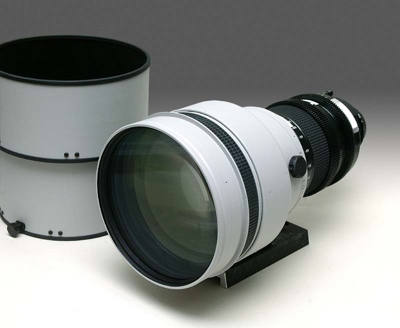 At the turn of the 21st century cinematographers and broadcast companies wanted yet more new 300mm f/2.0 lenses, this in spite of the available pool of mid-1980’s production 300mm f/2 ED IF lenses. But the photographic market was in transition to digital and world economic circumstances were volatile, so Nikon management was initially in no mood to manufacture a small quantity of niche products. But even by 2002 there was simply no practical alternative lens made to equal the Nikon 300mm f/2 ED IF. So when a broadcasting corporation approached Nikon with a proposition to buy a quantity of twenty (20) of these lenses made specifically for them and their affiliates, and at a then incredibly attractive price for Nikon of about $30,000 each, a deal was finally agreed.
At the turn of the 21st century cinematographers and broadcast companies wanted yet more new 300mm f/2.0 lenses, this in spite of the available pool of mid-1980’s production 300mm f/2 ED IF lenses. But the photographic market was in transition to digital and world economic circumstances were volatile, so Nikon management was initially in no mood to manufacture a small quantity of niche products. But even by 2002 there was simply no practical alternative lens made to equal the Nikon 300mm f/2 ED IF. So when a broadcasting corporation approached Nikon with a proposition to buy a quantity of twenty (20) of these lenses made specifically for them and their affiliates, and at a then incredibly attractive price for Nikon of about $30,000 each, a deal was finally agreed.
Right: the first Tochigi Nikon 300mm T2.2 lens with Lens Hood HK-29-1 and attached Lens Hood Extension HK-29-2 to the side, as produced in 2004.
The painted components of these lenses may be white as in the images here, or may be finished in medium to light gray. Production models seem to have the lens hood bolts painted.
Click on image to see enlarged view (194,292 bytes).
The Nikon Corporation group of nineteen companies operate under control of a President and Board of Directors. The project for the new 300mm lens was negotiated in 2001, and then assigned to the Tochigi Nikon Co. within the Precision Equipment Company of the Nikon Group. Tochigi is a company situated about 75 miles (120 km) north of Tokyo, with about eight hundred employees working at modern facility with a floor area of 470,6952 feet (43,7292 meters). This factory is best known for the manufacture of stepper motors, complex interchangeable lenses, and other industrial optics including the Nikon UV-105 F4.5 Lens lens distributed by Company Seven.
These new 300mm lenses incorporate twelve (12) elements, three (3) of these being ED elements, arranged in a nine (9) group lens design; this includes the protective front optical flat window. The optical design was updated, while the basic lenses arrangement is similar to that of the original Nikkor 300mm f/2 ED IF.
The lens focus is a similar IF arrangement, where the lens physical length overall does not change with changes of focus distance. Theses lenses blend in the features as implemented by Century Optics (then Century Precision Optics) and by Panavision making them well suited for high-speed broadcast video and cinematography. The result was marketed as the Tochigi Nikon 300mm T2.2 though the original literature from Tochigi translates to Tochigi-made 300 mm -2.2 (F 2.0) Lens. The lens is readily distinguished from the Century-modified Nikkor lenses that these are finished in a light gray paint (in some photos appearing white) with black anodized rear sections, and these lenses bear the "Tochigi Nikon" branding. The first lens of the series is Serial Number 200101, Company Seven’s owner has lens SN 200108.
Other aspects of the Tochigi Nikon 300mm T2.2 that distinguish it from the Nikkor 300mm f/24:
-
4. In terms of optical design the lens, with a Nikon F mount, would be perfectly compatible with the Nikon TC-14C. Note however, there was no matched teleconverter provided with this lens, as were included with the original Nikkor 300mm f/2. I use my own TC-14C, the Nikon TC-201, and more recently made Nikon 1.6x teleconverter.
5. When the lenses were made available for sale they were offered with the choice of an optional lightweight Nikon lens shade finished in gray, matching the lens. The lens shade option cost about $600.00 (USD).

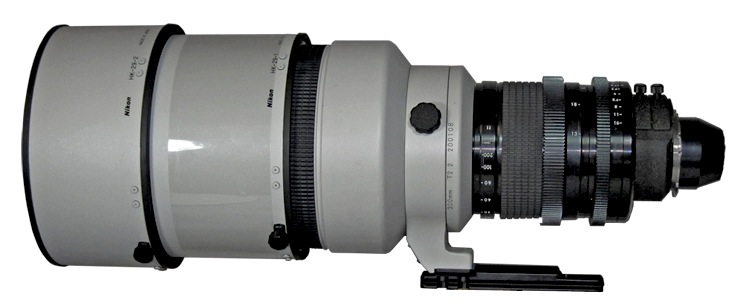
Above left: Tochigi Nikon 300mm T2.2 lens (SN 200108) lens, on exhibit at Company Seven (41,444 bytes).
Note: this is a new lens, so the Lens Hood HK-29-1 section still has one of protective plastic packing coverings around it.
Click on image to see enlarged view (255,799 bytes).
Above right: Lens shown with optional Wimberley Model AP-652 Dovetail Plate attached in place of Nikon Foot/Interface Plate.
This image conveys a better sense of the Nikon lens body’s actual gray tone (73,301 bytes).
Click on image to see enlarged view (127,668 bytes).
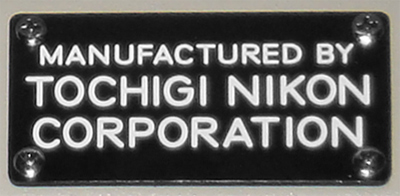 The lenses employed in cinematography are completely manually operated. By means of the gears over focus and diaphragm controls the cinematography team can either operate the lens locally manually, or can automate these functions for operation by remote control. Cinematography is a meticulously planned and well thought-out work, with immense overheads of people and equipment on a location. Because of the pressures on a film production crew to get it right the first time, the camera and lighting operators will have rehearsed the working focus distances, nominal apertures, and filtering, rehearsing these aspects and setting manual queues or programming automated control components so that the lens can be ready for each filming session. Hence, the lens need not be provided with Depth of Field indicators or an Infrared focusing index. As such, even in 2004 when automatic focussing lenses dominated the professional conventional photography market, these Tochigi Nikon 300mm T2.2 lenses were specified as manually operated lenses.
The lenses employed in cinematography are completely manually operated. By means of the gears over focus and diaphragm controls the cinematography team can either operate the lens locally manually, or can automate these functions for operation by remote control. Cinematography is a meticulously planned and well thought-out work, with immense overheads of people and equipment on a location. Because of the pressures on a film production crew to get it right the first time, the camera and lighting operators will have rehearsed the working focus distances, nominal apertures, and filtering, rehearsing these aspects and setting manual queues or programming automated control components so that the lens can be ready for each filming session. Hence, the lens need not be provided with Depth of Field indicators or an Infrared focusing index. As such, even in 2004 when automatic focussing lenses dominated the professional conventional photography market, these Tochigi Nikon 300mm T2.2 lenses were specified as manually operated lenses.
Right: Tochigi Nikon label plaque bolted onto the front of the 300mm T2.2 lens (SN 200108) foot. From lens exhibited at Company Seven (41,444 bytes).
The original drawings dated 2002 and the announcement from Tochigi Nikon mentions the Arri PL mount; this is how all lenses were originally commissioned to be made. However, later Fall 2004 literature mentions the availability of at least some lenses with the Nikon F mount. These two appear to have been the only lens mount choices available for the lens from the factory. The lens in our collection arrived with a Arri PL ("Positive Lock") bayonet lens mount, this steel male flange is attached into the rear of the Nikon lens by means of eight bolts. By the time this article was being researched Nikon of Japan was advising these lenses were only delivered with the Arri PL mount; this contradicts older literature. While I have seen several of these lenses shown with Nikon F mount, I have not been able to definitively prove whether or not they came from the factory in that Nikon mount configuration or were modified by a third party after delivery.
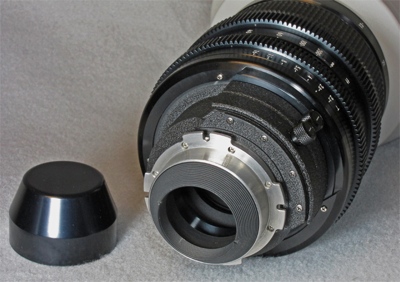 The robust stainless steel Arri PL mount is among the more recently developed lens mount standards, first released at Photokina 1982. The PL mount consists of four flanges, any of which can be used to align the mount to a locating pin located approximately 45 degrees clockwise from the top of the camera’s lens mount. So the lens can be oriented in any of four different configurations decided by factors including the focus puller position or camera orientation. The mount is locked into place using a friction locking ring which, in conjunction with the four prongs of the flange, creates a very strong lens seating that can deal with the greater stresses placed upon the mount by newer cameras and their associated devices.
The robust stainless steel Arri PL mount is among the more recently developed lens mount standards, first released at Photokina 1982. The PL mount consists of four flanges, any of which can be used to align the mount to a locating pin located approximately 45 degrees clockwise from the top of the camera’s lens mount. So the lens can be oriented in any of four different configurations decided by factors including the focus puller position or camera orientation. The mount is locked into place using a friction locking ring which, in conjunction with the four prongs of the flange, creates a very strong lens seating that can deal with the greater stresses placed upon the mount by newer cameras and their associated devices.
Left: Arri PL lens mount bolted onto the 300mm T2.2, its cover is to the side. Note two drop-in filter holders. From lens in collection of Company Seven (52,965 bytes).
Click on image to see enlarged view (258,607 bytes).
Interchangeable lenses and camera systems must comply with their manufacturers lens back focus (flange focal distance or focal plane distance) specification. That is the spacing between the rear surface of lens mount flange ring to the film plane. Compliance with this specification insures the lens will reach focus at all designed working distances from near to infinity. This spacing differs from one makers system to another makers system so when interchanging lenses from one mount to another compliance with this value is critical. The Tochigi Nikon 300mm T2.2 lenses provided with the Arriflex PL mount provide a flange focal distance (FFD) of 52.00mm (2.05 inch), sometimes termed "lens back focus", this is a measure of spacing from the rear surface of lens mount flange ring or the front surface of a camera lens mount back to the film (or CCD sensor) plane.
With the PL standard providing such a comparatively long lens back focus it is possible to buy a camera adapter from third parties that permit the lens to be used onto other cameras. To adapt the lens for other mounts one simply unbolts the Arri PL mount and attaches another suitable spacer and lens mount. Some companies modify conventional SLR cameras to accept the Arri PL mount lenses, so it is possible to order a Canon EOS camera for example adapted to go right onto this or any Arri PL lens! However, there can be no adapter made to permit the PL lens mount to go onto the Nikon F mount camera body in part because the PL mount has a larger 54.00mm diameter and a depth that can damage the flip mirror in a Nikon camera body. Therefore, to convert the lens it seems one might have to unbolt the PL flange and install a suitable bayonet with a suitable spacer. The Nikon F-mount features a three lug bayonet mount with a 44mm throat and with a flange to focal plane distance of 46.50mm, so in order to comply with this requirement any adapter and lens mount made for this lens will incorporate a machined aspect or spacer that assures proper compliance. For use with a Nikon F Mount for example it appears that Nikon furnished these lenses with a machined spacer that bolts on in place of the Arri mount, then the F Mount is bolted onto the spacer.
Some years later the Nikon Z mirrorless digital cameras, and others by Canon and Sony for example, with less back focus needs, can be employed by using an Arri PL to '’x’ brand mount adapter. It is even possible to attach some medium format camera, including the Fujinon GFX series, by means of a PL to GFX adapter! Now many things are possible with PL mount lenses than were originally envisioned.
For cinematography and other studio work the camera and the lens are usually well supported, attached together onto a rail and camera cradle set. The Arri PL mount is such a strong and reliable mount that those who intend to employ this lens with unconventional cameras, third party scientific imaging systems for example, might do best to buy a female Arri PL fitting and adapt that to fit their camera system. In this way the substantial loads of these systems, camera with color filter wheel and adaptive optics as typically used on a telescope for example, may be better supported than by relying on traditional Nikon or other lens mounts that were never envisioned as managing heavier payloads. The use of a camera and lens support rail should nonetheless be employed whenever practical.
Unlike the original Nikkor 300mm f/2 ED IF lens, the filter holder slots of the Century-modified Nikkor and Tochigi Nikon 300mm f/2 ED IF are positioned behind the lens diaphragm. We find it interesting that that for this production lot these Nikon lenses incorporate a Dual Stage Filter Holder configuration; the lens accommodates two 52mm Drop-in Filter Holders (Nikon Part No. 2459), each with a provided NC Filter threaded in place. The multicoated Nikon 'Neutral Color' filter is similar in its protective aspects to the 52mm L37c type of filter previously issued with the Nikon telephoto lenses. However, the NC filter is engineered for use with modern digital cameras instead of film cameras; the NC filter is not designed to cut longer ultraviolet wavelengths, as was the L37c, since modern digital cameras employ either windows (on CCD) or CMOS sensors made to effectively block UV starting at about 420nm and below. Having the filter in place 1. serves to prevent dust from entering the lens from the rear, and 2. these glass elements maintain the nominal back focus distance that is critical for planning focus of scenes when using the lens in cinematography. For astrophotography or other applications where any fraction of light loss is not desired, one may remove the NC filters altogether from the holders then adjust focus as necessary.
The user can employ in-line any one or two of the standard Nikon drop-in filter holders with a compatible thread-in 52mm filter (as provided), or with a Gel filter holder and filter, or with a Nikon C-PL1L (Part No. 2474). The optional C-PL1L assembly includes the 52mm diameter Polarizing Filter threaded into its drop-in Filter Holder with a mechanism to rotate the filter by means of a readily accessible manual control dial. Installing a C-PL1L filter into each of the two slots would allow the user to vary the attenuation from light to very dark; this may be desired for some special effects such as blurring motion while preserving a comparatively narrow depth of field.
Right: Nikon C-PL1L (Part No. 2474) Circular Polarizing Filter, note textured finish on the top exterior panel (59,188 bytes). In Company Seven’s collection.
Click on image to see enlarged view (118,194 bytes).
The protective front window is held in place by a thread-on retaining ring. This ring is thinner and appears lighter weight than that used on the original production Nikkor 300mm f/2 EDIF lens. The original ring has a post style opening to accept cylindrical pin tipped spanner wrench. The Tochigi Nikon 300mm lens retaining ring has two notches that would be serviced by a spanner with a flat blade tipped spanner wrench.
Aside from the practical considerations mentioned before, since these lenses must be adaptable for use with many types of film and digital cinematography cameras, so there is no practical way to make these lens with autofocus that can also communicate back and forth to the many camera communications linkages and protocols.
The Lens Foot of the Tochigi Nikon lens (shown in the image below left) is similar to that of most modern Nikon ultra telephoto lenses. This support platform is a low-profile arrangement that keeps the center of gravity closer to the platform than did the original Nikkor 300mm f/2.0 ED IF and most other large Nikkor lenses. The foot incorporates a matte black anodized interface plate, that is bolted onto the Lens Collar casting by four 4mm x 0.7 bolts. So while at first glance the plate provides the one centered ⅜ inch - 16 tpi threaded center hole, it is the four 4mm bolts of the interface plate that actually bear the load. The 4mm bolts can be removed and the foot interface plate removed to accommodate any number of third party dovetail plates or adapters as needed. Attaching the lens by the one ⅜ inch bolt alone in unconventional uses (astrophotography for example) will not guarantee the lens might not work its way loose and rotate left to right, so we recommend use of an auxiliary plate bolted directly onto the four tapped 4mm holes.
The lens illustrated in this article is provided with a Nikon HK-29 two section slip-on Lens Hood set consisting of HK-29-1 and a HK-29-2 Extension section. The HK-29-1 slips onto the front of the lens and clamps into place, while the HK-29-2 Extension similarly attaches onto the HK-29-1. The hoods are made of carbon fiber with plastic and metal components so both sections combined weigh just under one pound. The interior of each section is lined with black velour to prevent undesirable reflections off these walls. This set is nearly identical to the HK-29 Lens Hood set (P/N 4741) provided by Nikon with the AF-S Nikkor 600mm f/4D IF-ED II (P/N 2133) autofocus lens except the set for the Tochigi Nikon lens is painted gray to match the lens, while that for the Nikon lenses are usually painted black or left showing a carbon fiber twill pattern.
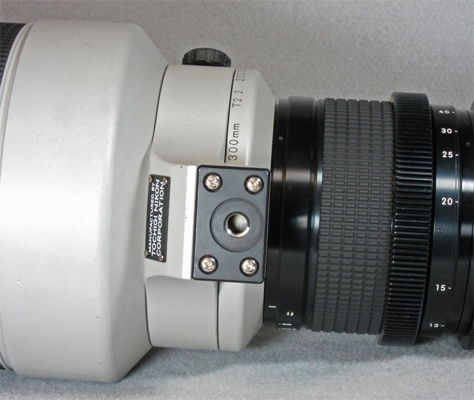

Above: Lens Foot/Interface Plate and Rotating Collar, and to the right is the Nikon HK-29 two section slip-on Lens Hood set (62,972 and 64,097 bytes).
Note: this is a new lens in the collection of Company Seven, so the Lens Hood HK-29-1 section still has one of protective plastic packing coverings around it.
Click on images to see an enlarged view (260,354 and 250,437 bytes).
You might wonder "how is it that a lens hood for a 600mm f/4 lens is provided with a 300mm lens?", well the Nikon engineers came up with a way to employ their existing inventory of production lens hoods rather than design an entirely new unit for this one small production lot of lenses. They simply designed the front of this lens so that it will seat the lens hood further down the barrel from the front. So the lens hood does not protrude any farther forward of the lens than the optical designers suggest it should. By doing this they moderated the cost of the set, and make it easier for the end user to source a replacement lens hood should it ever become necessary. So if you happen to have acquired a Tochigi Nikon 300mm T2.2 lens without lens hood, then you could order the HK-29 Lens Hood set (P/N 4741) that will perform just fine.
The down sides of this lens hood arrangement are practical and cosmetic: 1. it is not possible to retract and store the lens hood on the lens then attach the extension, as could be done with the original Nikkor 300mm f/2 lenses for compact storage. And 2. it is impossible to slide the lens hood onto the Tochigi Nikon 300mm T2.2 lens and clamp this into place without somehow marring the gray paint of the lens. On black finished lenses this wear and tear is usually unseen, but here the gray finish shows everything. We recommend keeping the lens with its lens shade attached in a well made custom fitted case.
The provided slip-on leather Lens Cover with rope drawstring and clamp appears identical to those (P/N 4743) provided by Nikon with the original 300mm f/2 ED IF, 400mm f/2.8 ED IF, and 600mm f/4 ED IF series lenses. Incidentally, to store the lens shade HK-29 with added protection one could purchase a second slip-on leather Lens Cover. Unlike the original Nikkor and Century-modified lenses, no trunk was provided with these lenses instead they were shipped from Nikon in a carton (17 x 10-½ x 10-½ inches) with simple cut polyethylene closed cell foam pads.
The adjustable iris diaphragm in the rear of these lenses are treated to prevent internal reflections off the blades. The lens elements edges are darkened too. So as with the original Nikkor 300mm f/2 ED IF looking into the front of a Tochigi Nikon 300 T2.2 lens leaves one with the impression of looking into a large dark cave.
There is something else that we notice about these Tochigi Nikon 300mm T2.2 lenses that differentiate them from their predecessors; Nikon has learned a lot about improving multi-layer lens coating technology over the past twenty years and these lenses show it! When looking at straight in to the front of these lenses the elements truly seem to disappear. But just to avoid any confusion I point out the Tochigi Nikon 300mm T2.2 lenses were not manufactured with the "Nano Crystal Coating"; they predate this development. This innovative ultra-low refractive index coating differs substantially from conventional multi-later coatings. Originally termed "Nano Particle Coating", this was developed by Nikon engineers Issei Tanaka and Tsuyoshi Murata who demonstrated the first sample to the public at the 2004 Photokina. The coatings were first released in a production lens in 2005, applied to the AF-S VR Nikkor 300mm f/2.8G IF-ED.
The Tochigi Nikon T2.2 clear aperture of the lens front window is 150mm, reduced from the original 152.5mm diameter of the Nikkor 300mm f/2 lens; this results in an aperture area difference between the two lenses of about three (3) percent. It may be that with the improved light throughput of the Tochigi Nikon T2.2 however, it would be difficult to discern any effective differences.

Above: profile and optical arrangement of the 2002 revised design of the lens. Marketed as "Tochigi Nikon 300mm T2.2", the most obvious
difference between it and the original 1981 design is the provision for a second 52mm drop-in filter at rear (168,224 bytes).
This became a lens that almost wasn’t: after the order was placed with Nikon to make the planned lot of twenty lenses, the circumstances at the broadcast company that ordered the lenses from Nikon changed and the order was cancelled after it was well under way. Nikon no doubt ordered some extra lenses made to plan for losses during production, or other uses. Fortunately for some Nikon was so far along in production that they decided to offer the lenses on the open market, after production concluded in the Fall of 2005, at a reduced price of about $20,000 USD each; if the original customer forfeit their deposit then this could have moderated the market price. The announcement from Tochigi translates to read "opportunities available in these conditions is unlikely in the future". By the end of 2006 Nikon sold all of the new lenses to its distributors.
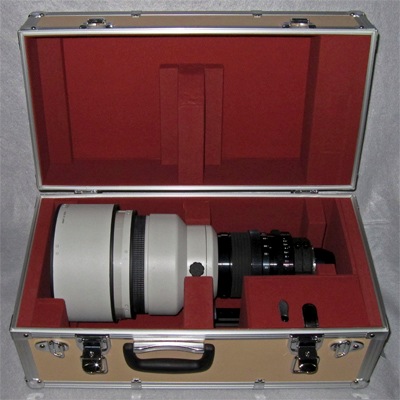 At Company Seven we do not fully understand all that went on with the original cancellation of the order. Nor do we know how or where the twenty-some 300mm T2.2 lenses were allocated, but we understand they were spread far and wide. Before we contacted them for input on this article, Nikon USA did not seem to have any clue that these lenses ever existed.
At Company Seven we do not fully understand all that went on with the original cancellation of the order. Nor do we know how or where the twenty-some 300mm T2.2 lenses were allocated, but we understand they were spread far and wide. Before we contacted them for input on this article, Nikon USA did not seem to have any clue that these lenses ever existed.
Right: Tochigi Nikon 300mm T2.2 lens (SN 200108) with Arriflex Mount cover on, with Lens Shades attached and stowed, in optional fitted lightweight carrying trunk.
The provided Leather slip-on Lens Cover removed to reveal Lens Shade more clearly, trunk Carrying Strap and other accessories stored in compartment (43,436 bytes).
The specifications of the Tochigi Nikon 300mm T2.2 lens (SN 200108 in our collection):
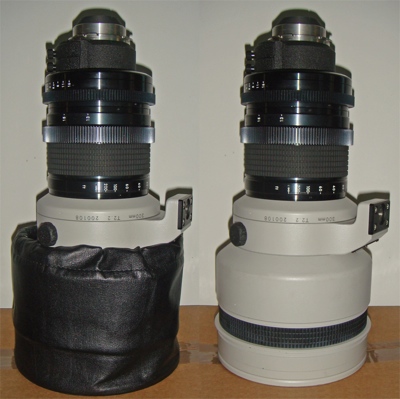 Lens Production and Current Status Summary:
Lens Production and Current Status Summary:
|
Right: Tochigi Nikon 300mm T2.2 of 2004 (SN 200108) - still the fastest 300mm lenses ever made - unrivaled since. The 2004 production features changeable camera body mounts, two 52mm drop-in filters slots, gears to drive the lens manually or automatically (astrophotographers listening?). The provided leather lens cover is large enough in diameter to only cover the lens without the HK-29 Lens Hood attached. These lenses deliver amazing performance, even hand held and under all conditions. Lens is in collection of Company Seven’s owner (57,083 bytes).
Pricing, Availability, Conclusions:
The Nikkor 300mm f/2.0 ED IF lenses sold new for as little as $4,200 (USD) towards the end of the 1985 production series at Nikon. But in the years soon after the production terminated the demand for these lenses by cinematography companies drove the market pricing up to $15,000 or more each. By 2000, "McBroom’s Camera Bluebook - 6th Edition" mentioned these lenses as being valued up to $25,000 for use in the cinematography market, this may have contributed to the request for Nikon to make the Tochigi Nikon 300mm models in 2004. However, between 2007 to 2010 the actual selling prices moderated as the newer generations of lenses with autofocus and vibration reduction came on the market. Not everyone noticed the drop since as recently as December 2010 a complete used 300mm f/2 ED IF lens set in well worn but optically sound condition sold on eBay for $15,000. Soon after that a set with very few signs of use was marketed asking $13,000 but that did not invite a single offer. On the other hand in April 2007 a complete and nearly like new Nikon 300mm f/2 ED IF lens (SN 182497) sold at LiveAuctioneers (Lot 34), in Chester, New York for $6,250.00 though its TC-14c sold separately for about $500; how foolish must a fellow paying fifteen grand feel if he reads that?
We have observed several lenses modified for cinematography coming up for sale over the recent years. We wondered if the lenses were falling out of favor, but have since been reassured no, that it is simply a result of cinematographers who acquired lenses in the mid 1980’s retiring. The modified lenses tend to command somewhat lower prices than the highest prices an original Nikkor version of the lens, even these modified lenses are arguably more versatile and more likely to generate revenue for a working cinematographer than any original Nikkor 300mm f/2 ED IF could. The Century-modified Nikkor 300mm f/2 lens we purchased (SN 182429 shown above) had minor pitting of the front window, we bought that for $7,500. Throughout the Fall of 2010 and into 2011 another Century-modified Nikkor 300mm f/2 lens, in well used condition, was asking $14,400 with no offers. We then spent $900 to replace the front window and upgrade the slide-in Tiffen Clear filter. Soon after this the new Tochigi Nikon T2.2 lens (SN 200108 shown above) arrived and so we decided to sell the Century-modified lens; that sold for $8,000 USD. We have seen fewer of the Panavision modified lenses come up for sale used on the open market; this may be attributable to the fewer numbers converted.
We have heard one report of one company or auction site in Asia advertising a Tochigi Nikon 300 T2.2 lens some years ago for 680,000 ¥ plus 68,000 ¥ for the carbon fiber Lens Hood, then about $9,000.00 USD but we never verified that. We confirmed one demo Nikon 300 T2.2 lens was offered for sale by a company in Germany as late as in 2009 for 15.399,00 € (Euro), then about $21,000.00 USD. Other than the new lens we acquired SN 200108, and lens SN 200104 owned by an amateur astronomer in Japan, and lens SN 200123 (Nikon mount), we can not verify the disposition of other twenty or so Tochigi Nikon 300mm T2.2 lenses.
Regardless of the market valuations, of these three lens variants we consider the original Nikkor 300mm f/2 ED IF to be most handy and even hand-holdable version of these lenses, at least by some people. It can be convenient to have one lens in a bag that with a suitable telecompressor works as either a 300mm f2.0, 420mm f/2.8, or 600mm f/4. But few people today will want to hand carry a 17 lb. (7.73 kg) lens that is lacking autofocus and vibration reduction. Without the luxury of a carrying strap, it will be a difficult matter for anyone to tote a Century, Panavision or Tochigi Nikon 300mm T2.2 lens across any distance. And with digital SLR’s evolving with newer sensors that are increasingly sensitive to low light, the financial return of paying for extreme lens speeds may diminish. So no matter how rare the lens is, by 2011 it will rarer still to find anyone to pay a premium price for it.
If we move beyond the initial shock and awe sensations of seeing and of hand-holding the 300mm f2.0 ED IF lens, and then weigh their performance against other practical concerns of weight, and factor modern conveniences of vibration reduction and auto-focus (for some “girly photographers”, they are necessities), then making the choice among these monster lenses can be done dispassionately. Consider and compare the best 1980’s tech against that offered today, and their pricing too:
|
better suited for a number of applications...while being more readily adaptable for many other uses”
When searching out one of these lenses first consider whether or not you really need one, or just want one. Judge the completeness of the set (do you need the Nikon TC-14C?, do you need the auto iris diaphragm linkage?) and the condition of the lens keeping in mind it is impossible to find most repair parts, even from Nikon, so long after the lens was made.
But all that does not matter to the author of this article, because he will have one of each to choose from!
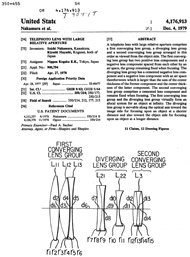 Nikon 200mm f/2 Lens Design Patent The 11 page Patent .pdf file (431,562 bytes) |
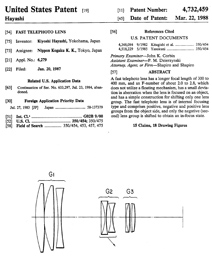 Nikon 300mm f/2 and 400mm f/2.8 Design Patent. The 24 page Patent .pdf file (582,428 bytes) |
 Instruction manual for 300mm f/2 EDIF lens .pdf of an original in Company Seven Archive |
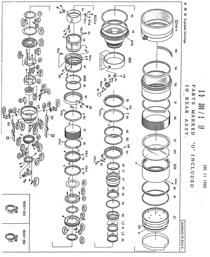 Nikon 300mm f/2 parts drawing & list a 4 page .pdf file (498,005 bytes) |
Contents Copyright 1987-2024 Company Seven and respective contributors, All Rights Reserved


